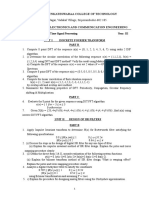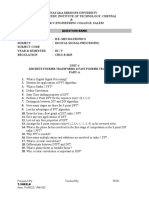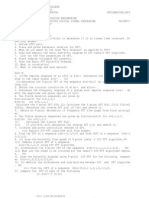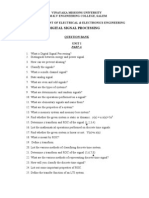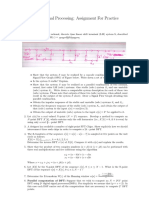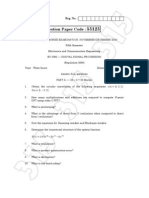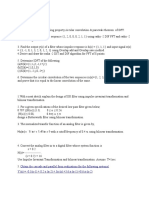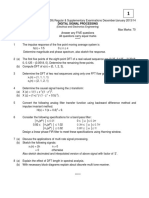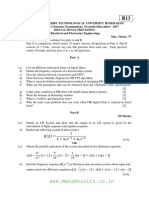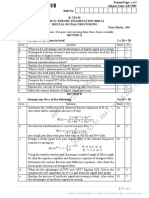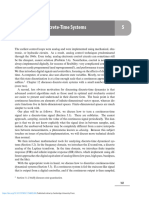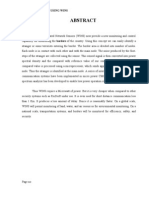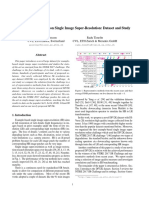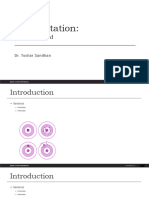P13EC44 Page No...
1
U.S.N
P.E.S. College of Engineering, Mandya - 571 401
(An Autonomous Institution affiliated to VTU, Belagavi)
Fourth Semester, B.E. - Electronics and Communication Engineering
Semester End Examination; May/June - 2018
Digital Signal Processing
Time: 3 hrs Max. Marks: 100
Note: Answer FIVE full questions, selecting ONE full question from each unit.
UNIT - I
1 a. Find the 4-point DFT of two sequences g(n) and h(n) using a single 4-point DFT.
↓
6
g (n) = (1, 2, 0,1) and h(n) = (↓,1, 0, 2)
b. x(n) and h(n) are two frequencies of length 5 each defined as x(n) = n for 0 ≤ n ≤ 4 and
h (n) = u (n) – u(n-2). Compute the circular convolution between x(n) and h(n) using 8
frequency domain approach.
c. State and prove circular convolution property of DFT. 6
2 a. Consider a FIR filter with impulse response h(n) = {3, 2, 1, 1} . If the input to the filter is {1,
2, 3, 3, 2, 1, -1, -2, -3, 5, 6, -1, 2, 0, 2, 1}, calculate the output response of filter using overlap 10
add method by assuming a block length of 7.
b. Find the energy of the 4-point sequence x(n)=sin( 2Nπ n) 4
c. Find the IDFT of X(K) = {2, 1+j, 0, 1-j}. 6
UNIT - II
3 a. Develop 8 point DIT-FFT radix -2 algorithms and draw the signal flow graph. 10
b. A designer is having number of 8-point FFT chips. Show explicitly how he should
6
interconnect these chips in order to compute a 24-point DFT.
Find the 4-point IDFT of the sequence x (k) = {6,-2-2j, 2, -2+2j} using DIF FFT algorithm. 4
4 a. Compute the circular convolution between two sequence x(n) = {1,1,1,1} and h(n) = {1,0,0,1}
10
using DIF FFT algorithm.
b. For the sequence x(n)={1,0,1,0}, determine X[2] using Goetzel algorithm 6
c. Assume that a complex multiplication takes 1 µsec and the amount of time taken to compute
N-point DFT is determined by amount of time it taken to perform all of Multiplication.
4
i) How much time it taken to compute 64-point DFT directly?
ii) How much time is required if an FFT is used?
UNIT - III
5 a. Design a FIR low pass fitter with cutoff frequency of 1 KHz and sampling frequency of 4 kHz
8
with 11 samples using Fourier series method.
b. Design an analog low pass Chebyshev type-I filter that has -3dB cut-off frequency of
2 radians /sec and stop band attenuation of 25 dB or greater for all radian frequencies greater 12
for all radian frequencies greater than 5 radians/s.
Contd…2
� P13EC44 Page No... 2
6 a. A low pass FIR filter is to be designed with the following desired frequency response.
− j 3w 3π
e for w <
4
H d ( w) = 10
0 3π
for < w <π
4
Determine FIR filter coefficients using Hamming window approach for a length of N = 7.
b. A fifth order analog low pass Butterworth filter has a pass band edge frequency 2 kHz and
maximum pass band attenuation of -2dB. What is the actual attenuation in dB of low pass 10
filter at a frequency 4 kHz?
UNIT - IV
7 a. Distinguish between IIR and FIR filter. 4
b. Derive an expression for order of a low pass Butterworth filter. 6
c. Design and realize a digital low pass filter using Bilinear transformation method to satisfy the
following characteristics.
10
i) Pass band ripple 1.25 dB; ii) Pass band edge = 200 Hz; iii) stop band attenuation = 15dB;
iv) Stop band edge = 400 Hz; v) sampling frequency = 2 kHz . Assuming T = 2 s.
8 a. Design a Chebyshev digital IIR Low pass filter using impulse invariant transformation by
taking T = 1 second to satisfy the following specification :
0.9 ≤ H (eiw ) ≤ 1.0 0 ≤ w ≤ 0.25π 12
H (eiw ) ≤ 0.24 0.5π ≤ w ≤ π
b. The normalized transfer function of an analog fitter is given by,
1
H ( Sn ) =
S + 1.414 2 S n + 1
2
n 8
Convert analog filer to a digital filter with cut off frequency of 0.4π, using bilinear
transformation.
UNIT - V
9.a Obtain direct form – I direct form – II and cascade form realization of following function
8Z 3 − 4Z 2 + 11Z − 2 12
H (Z ) =
( z − 0.25)( Z 2 − Z + 0.5)
b. Obtain parallel realization for the system represented by the following system function.
1 + 1/ 4 Z −1 8
H (Z ) =
(1 + 12 Z −1 )(1 + 12 Z −1 + 14 Z −2 )
10 a. Realize FIR filter with impulse response h(n) given by
h ( n ) = ( 12 )n [u (n) − u (n − 4)] 10
Using direct form – I and direct form – II
b. Given the FIR filter with following difference equations
y (n) = x(n) + 3.1x(n − 1) + 5.5 x(n − 2) + 4.2 x(n − 3) + 2.3 x(n − 4) 10
Sketch the lattice realization of the filter.
****



